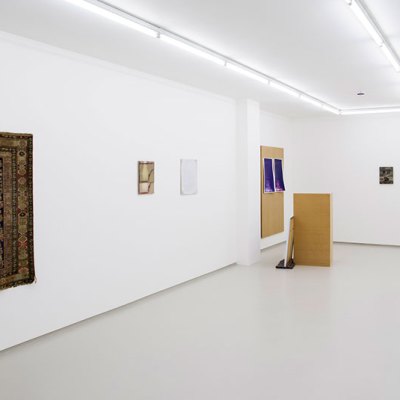In 1971, the artist Elaine Sturtevant – or just plain Sturtevant, as she signed and styled herself – created a film entitled Study for Various Beuys Actions. In this grainy black and white work, Sturtevant carefully re-stages performances and interventions by the German artist Joseph Beuys using her own body: the result occupies an intriguingly grey area between re-performance, study, appropriation and homage. Its status became further complicated by the fact that when Beuys travelled to New York in 1974 for his major performance I Like America and America Likes Me, US audiences already knew his work through Sturtevant’s film and recreations of his sculptures.
Such chronological blips landed the artist, as she wryly put it, in the ‘perverse, simultaneous double trouble of being ahead and being behind’ – a phrase that encapsulates the complexities opened up by Sturtevant’s consistent engagement with repetition and emulation. Beginning in the mid 1960s, she shifted her entire practice to making versions of works by her contemporaries – such as Beuys, Claes Oldenburg, Andy Warhol, Jasper Johns and Roy Lichtenstein – that were as exact as possible in their recreation of the original.
Such a project, of course, throws the entire concept of ‘originality’, together with its close companion ‘authenticity’, into radical confusion. Sturtevant’s work certainly got her in trouble: some of the artists subjected to Sturtevant’s attentions responded to her work’s subversive qualities. Unsurprisingly, Andy Warhol gleefully entered into her game (when an interviewer asked him how he made his work, Warhol laconically responded: ‘I don’t know, ask Elaine’). Others, such as Oldenburg, were less pleased, presumably disconcerted by what they distrusted as opportunistic appropriation.
Warhol Flowers (1964–65), Sturtevant © Estate Sturtevant, Paris. Courtesy Galerie Thaddaeus Ropac, Paris–Salzburg

Yet Sturtevant always firmly refuted the status of the ‘copy’ when critics tried to apply it to her works. Instead, her pieces are more usefully approached as studies. The status of the study is both belated and anticipatory, a staging post on the way to further developments. A study of another artwork might be motivated by admiration, affinity, and not a little competition. It moreover sits within a wider history of artistic learning and exchange conducted through investigating and re-making the work of other artists which has a long and established educational history, embracing everything from drawing casts of ancient sculptures, to setting up an easel in galleries to paint the ‘old masters’.
Study for Muybridge Plate #97: Woman Walking (1966), Sturtevant © Estate Sturtevant, Paris. Photo: Alex Jamison

Sturtevant often engaged in dialogue with her sources rather than creating exact replications. In this respect, the photographic works included in the Museum of Modern Art’s highly enjoyable exhibition are particularly fascinating. In Study for Muybridge Plate no. 97: Woman Walking (1966), Sturtevant not only re-enacted the movements of an Edward Muybridge photo-series, but did so against her versions of Johns and Lichtenstein. For Duchamp, Marcel Duchamp (1993), Sturtevant returns to Duchamp’s 1912 painting Nude Descending a Staircase No.2 but presents multiple exposures of her own body in the place of the nude. The image blurs distinctions between artist and model, and in so doing extends Duchamp’s own interest in gender play, notably through his alter ego Rrose Sélavy.
Doublings – even triplings and quadruplings – abound in Sturtevant’s practice, and the curatorial strategy in ‘Double Trouble’ helpfully illuminates them through her particular relationships with the work of Beuys and Duchamp, in a way that also underlines her use of performance to destabilise identity. For Dillinger Running Series (2000), a single-channel video projected from a rotating platform, Sturtevant had herself photographed mid-stride, wearing a Beuysian fedora, emulating the other artists’ stance in a short film he made which documented his own re-enactment of a 1934 gangster killing. The figure of Sturtevant-as-Beuys-as-Gangster circles around the room to a soundtrack of frenetic pacing, flickering in and out of the shadows cast by galleries of viewers: now you see her, now you don’t.
‘Double Trouble’ culminates with the multi-screen video Electric Tango of 2010, made four years before the artist’s death in 2014. Stacked in a bank intended to reference the displays in electrical stores, the individual monitors relay loops of Sturtevant’s re-performances and re-inventions, spliced with iStock videos and recordings of advertisements. It’s a glorious conclusion: loud, busy and engrossing, while demonstrating the depth and breath of an often misunderstood practice that went well beyond simplistic notions of appropriation art.
‘Sturtevant: Double Trouble’ is at the Museum of Modern Art (MoMA), New York, until 22 February.
Related Articles
Sturtevant, forerunner of ‘appropriation art’ has died (Maggie Gray)
Nothing new? The row over Marina Abramović’s new show (Maggie Gray)
Right or Wrong? Is it time to rethink copyright legislation?
Go With The Flow: William Morris and Andy Warhol at Modern Art Oxford (Matilda Bathurst)
From the mass market to the museum: ‘Warhol Mania’ in Montreal (Elizabeth Grant)
More than just copies: Brussels’ Plaster Cast Workshop (Ruth Allen)





